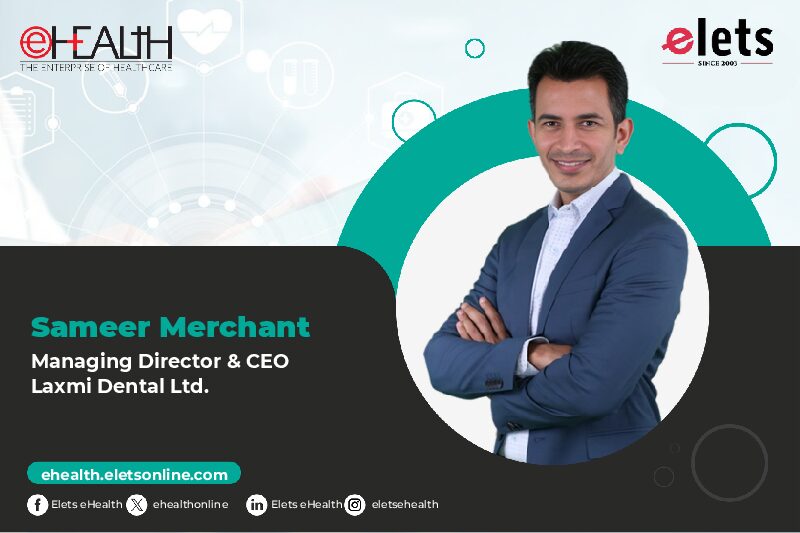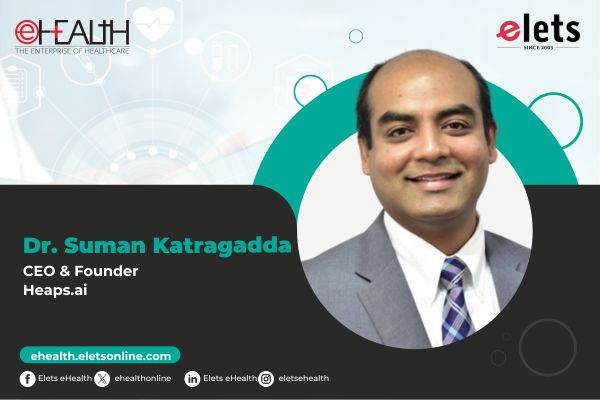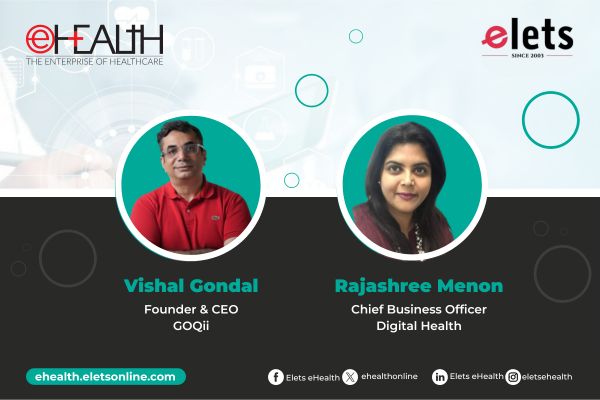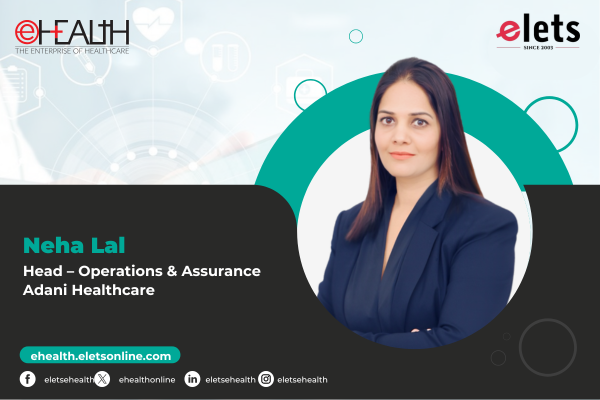
 Technological innovations are taking place with a significant growth, changing the shape of various industries as these evolve. Technology plays a pivotal role in all processes, starting from registration of patients to data monitoring, from lab tests to selfcare tools in the healthcare domain Romiya Das of Elets News Network (ENN) finds out how the use of information technology is transforming the way healthcare is being delivered to the patients
Technological innovations are taking place with a significant growth, changing the shape of various industries as these evolve. Technology plays a pivotal role in all processes, starting from registration of patients to data monitoring, from lab tests to selfcare tools in the healthcare domain Romiya Das of Elets News Network (ENN) finds out how the use of information technology is transforming the way healthcare is being delivered to the patients
Hospitals are adopting IT fast and replacing the conventional methods of monitoring and recording systems. Now, people can avail the facility of consulting doctors from the comfort of their homes Advancements in healthcare technology has contributed immensely to taking medical facilities out of the hospital periphery and integrating those with easy to use devices, thus enhancing the accessibility to healthcare services.

Going back to 90s, hospitals used to have a small department that did mundane things such as billing and printing of medical reports, patient administration, purchase, finance, inventory management, etc. During those days, the earlier versions of Hospital Information System (HIS) took shape in the form of in-house IT systems. However, with the turn of the century, these applications started surfacing as standard products being configured and implemented as per specific requirements of the hospitals. It also added lab and radiology reporting workflow, integrating lab analysers with HIS, booking appointment and many more.

Towards the end of 2000s, major hospitals had HIS system to manage patient data, employee data, material, lab and radiology, revenue and expenses, accounting, billing, etc. Later, within four to five years,Electronic Health Record (EHR) and Picture Archival & Communication System (PACS) were the two major developments that took place. EHR revolutionised the paperless patient records by automating them, while PACS helped patients and doctors by storing X-Ray, CT-scan, MRI images digitally. The year 2010 saw information technology emerging as the core infrastructure for healthcare delivery.

Ever since, IT has evolved and benefitted hospitals making it an integral part of the service delivery system in hospitals. Some of the major developments include

Management and Analysis of Big Data: Analysis of Clinical Research Data, and Generation and Storage of Biometric Data, like Fingerprints, Genetic Information, etc., have become possible through continuous advancements in IT.
Cloud Computing: Through Cloud Computing, it has been possible to share infrastructure in which large pools of systems, such as data storage space, networks , computer processing power and specialised corporate or user applications, can be linked together and users have the freedom to access information from anywhere at any time. Enterprise collaboration, storage of EHRs and others have hence become easier.
Electronic Health Records (EHR): EHRs have made it possible to integrate text, voice, images and handwritten notes. Real-time access to patient data, reduction of time to enter patient data, reduction in cost and space for storage of data are the benefits of EHR.
Radiology Information Software (RIS) and Picture Archiving & Communication System (PACS): RIS and PACS have revolutionised the management of medical imagery associated data. It has enabled long-term cost savings and simultaneous multi- location viewing of images.
mHealth and Telemedicine: Use of mobile communication devices to deliver health services to patients has ensured delivery of timely and efficient health services and has benefited rural parts of the country immensely. Information technology has significantly improved three crucial facets of healthcare delivery outcome, affordability and accessibility. Every aspect of medical and healthcare is getting automated for patients delight. Basic things, such as appointments and billings, are a no-brainer, but more importantly, printed advice (the proverbial doctors bad handwriting on prescriptions), EMR, follow-ups with consultations through video or telecon or email, or applications to keep them connected, remote diagnosis and patient feedback system, among others, says Ashok Jain, Founder of Lifespan. Across the
Information technology has significantly improved three crucial facets of healthcare delivery outcome, affordability and accessibility. Every aspect of medical and healthcare is getting automated for patients delight. Basic things, such as appointments and billings, are a no-brainer, but more importantly, printed advice (the proverbial doctors bad handwriting on prescriptions), EMR, follow-ups with consultations through video or telecon or email, or applications to keep them connected, remote diagnosis and patient feedback system, among others, says Ashok Jain, Founder of Lifespan. Across the
Every aspect of medical and healthcare is getting automated for patients delight. Basic things, such as appointments and billings, are a no-brainer, but more importantly, printed advice (the proverbial doctors bad handwriting on prescriptions), EMR, follow-ups with consultations through video or telecon or email, or applications to keep them connected, remote diagnosis and patient feedback system, among others, says Ashok Jain, Founder of Lifespan. Across the
 Across the globe most of the healthcare providers have harnessed IT adoption for business visibility. IT-enabled healthcare has improved the services in many ways. It reduces manual errors during diagnosis and treatment. A study conducted by Infoholic Research, IoT Healthcare Market Global Trends and Forecast 2016-2022 states that the Internet of Things (IoT) solutions will have a positive impact on healthcare services and that government spending on healthcare delivery will improve. The IoT market is expected to grow at CAGR of 43.01 per cent for the period of 2016 2022, according to the study. The new era of
Across the globe most of the healthcare providers have harnessed IT adoption for business visibility. IT-enabled healthcare has improved the services in many ways. It reduces manual errors during diagnosis and treatment. A study conducted by Infoholic Research, IoT Healthcare Market Global Trends and Forecast 2016-2022 states that the Internet of Things (IoT) solutions will have a positive impact on healthcare services and that government spending on healthcare delivery will improve. The IoT market is expected to grow at CAGR of 43.01 per cent for the period of 2016 2022, according to the study. The new era of
The new era of technological shift began with digital transformation of communication, which has completely changed the way doctors and patients used to communicate earlier. Although Indian healthcare spending is estimated to reach US$196 billion-mark by 2018, the sector is lagging behind in full exploitation of technological tools; deployment of IT systems has been happening at a slower pace compared to the countries in the West. However, Healthcare InformationTechnology (HIT) and HIS are used by big pharmaceutical companies, corporate hospitals and other private health sectors. Health insurance firms have also made adequate IT deployment for collecting, analysing and transferring information when needed.
Although IT requires high initial investments, it makes healthcare more affordable from the patients point of view. For instance, tele-consultation cuts down unnecessary travels. Patient portals enable the patients to access their medical reports at home rather than making visits to hospitals
Lifestyle-related chronic diseases are resulting from urbanisation, sedentary lifestyles, changing diets, rising obesity levels, and widespread availability of tobacco products. In addition, India has one of the worlds highest numbers of diabetes sufferers, at more than 65 million individuals. This trend has resulted in mushrooming of super-specialty hospitals to combat lifestyle diseases.
The technological advancements in healthcare analytics, informatics, telemedicine, remote diagnostic and therapeutic tools have changed the face of healthcare into tech enabled healthcare. Improved IT infrastructure for healthcare organisations will directly result in providing quicker, simpler and more efficient healthcare services. Also, focusing more on patients, who will now have direct access to many innovative applications, by smart devices is digitalising the perception of patients and taking a leap towards modern forms of best treatments and clinical expertise, opines K R Sreenivasan, Founder Director at Infoholic Research.
Tariq Ahmed Shaik from Research Operations at Infoholic Research said, Healthcare sector is dominated by private sector, comprising individual or group of doctors running clinics or nursing homes/trusts etc. The various models of hospitals have been benefited a lot with the introduction of various technologies and applications, such as HIS, ERP, PACS, EHR, Telehealth, mHealth, and web-based services. Enabling these robust technologies in hospitals has resulted in efficient management of patient records, as this is the key task for every hospital both in rural and urban areas. This also helps in prioritising the records and making it readily accessible, as patients visit is unpredictable can happen the next day, in weeks or maybe after 10 years. With increased adoption of these tech-savvy applications – patients are digitally connected to the hospitals and respective doctors and increasingly demanding deployment of robust IT infrastructure in the upcoming hospitals.
Information technology will revolutionise the hospitals with more digital trends in healthcare information and electronic medical records. Technically, IT will benefit hospitals, doctors and patients in more digitised formats to get them connected with ease and urgencies. IT is being used across hospitals to enhance the patient experience and deliver services efficiently. Some of the innovative use of information technology for patients delight include
Patient Portal: Hospitals design exclusive patient portals to enhance the patient experience. Features, such as digital self-scheduling or online appointment booking and billing, are being used by hospitals to reduce long waiting time and queues. Patients can now check, doctor schedules and availability online and schedule their visits as per their convenience.
Online Availability of Diagnostic Reports: Hospitals have made the availability of all diagnostic reports online. Patients can now check their reports at their homes and make a print whenever needed. This has reduced the TAT of the diagnostic departments and made it convenient for the patients.
Mobile or Health Application: These have enabled patients to monitor their health regularly. Post discharge, patients can now monitor their progress and also share the same with the doctors from the convenience of their home.
 Patient Engagement Programmes: Online patient engagement programmes are helping patients gain more knowledge on their health conditions and also learn ways to be healthier. These have also increased efficient Patient Doctor Interaction.
Patient Engagement Programmes: Online patient engagement programmes are helping patients gain more knowledge on their health conditions and also learn ways to be healthier. These have also increased efficient Patient Doctor Interaction.
Smart Card: Hospitals are issuing value or smart cards to their patients to ensure that they can avail additional benefits in all services.
Queue Management: These systems have enhanced the patient experience in the Hospital and reduced the workload of the OPD Staff.
Modular OT and Robotic Surgeries: High Precision Surgeries are now possible with robotic armsused in OT. This has improved the clinical outcomes and reduced the recovery time for patients.
Telemedicine: This has enabled patients to seek consultation from any location and is also immensely helping delivery of services in rural areas.
IT has grown into managing the way hospitals and clinics operate and serve. It helps in performance enhancement with new methods of patient management and CRM systems. Availing health records at the click of a button is a boon to individuals who need to access healthcare anytime, anywhere. Hospitals and clinics are moving from hand records and bills to consolidated data using CRM systems. This makes every data available to different departments of the hospital. Networking of systems across individual departments of the hospital makes it easy for transfers internally and other doctors in the system know what was done earlier within the setup. A unique patient ID is all it takes to access them, says Dr Sitaram Sundaresan, PhysioBeFit.
Although IT requires high initial investments, it makes healthcare more affordable from the patients point of view. For instance, teleconsultation cuts down unnecessary travels. Patient portals enable the patients to access their medical reports at home rather than making visits to hospitals. These are direct cost savings and thus make treatment affordable. Customer satisfaction is the key, and merit the benchmark for any service provider. The healthcare service providers do realise that, but in most cases, it is not pre-emptive.
 The healthcare insurance side of medicine is yet to unlock the real potential of IT, and the research and innovation that is enjoyed by the medical equipment and pharmaceutical counterparts. Parallel to the proposition for a universal health insurance cover, technology should be a key discussion point, as it would be the pillar on which 1.2 billion Indians would be insured and protected against out-of-pocket expenditures. Thus, progressive steps need to be taken in a direction that allows development and implementation of innovative technology solutions that can take the entire process of claim settlement online and ensure a hassle-free experience for the policyholder.
The healthcare insurance side of medicine is yet to unlock the real potential of IT, and the research and innovation that is enjoyed by the medical equipment and pharmaceutical counterparts. Parallel to the proposition for a universal health insurance cover, technology should be a key discussion point, as it would be the pillar on which 1.2 billion Indians would be insured and protected against out-of-pocket expenditures. Thus, progressive steps need to be taken in a direction that allows development and implementation of innovative technology solutions that can take the entire process of claim settlement online and ensure a hassle-free experience for the policyholder.
Munish Daga, Remedinet Technologies CEO, says, Hospitals are doing a lot to enable a great patient experience, such as using tablets and kiosks, TV monitors, token systems, accessing information in an electronic form, etc., which all help to keep information handy and enable access on the go. Furthermore, technology implementation, such as self-help kiosks and information monitors help reduce the dependence on the insurance desk and gives the policyholder the access to information as and when they need.
However, a lot more needs to be done to ensure that patients are not made to run from department to department for information and also reduce the long waiting hours that are still the norm, says Daga adding that despite all technology implementations, a policyholders representative still has to wait in queues and fill forms, and approach insurance desks every time they need an update on claim status.
Challenges for Hospitals
Adoption of IT and new technologies is a major challenge, and key factors contributing to the same are as follows:
Doctor and Staff Reluctance: Adoption of new technologies is time consuming, and acceptance from all end-users is necessary for effective implementation. Since, hospitals are driven by huge manpower, acceptance is a key challenge.
Effective Training and Implementation: Training and implementation of such systems is also time-consuming.
Costing: Implementation of IT initiatives requires huge investments and the RoI on them takes a longer time. Hence, investments need to be made by keeping in mind the goals and objectives of the system clearly.
Lack of Information: A lack of detailed, neutral information about technologies leaves hospital administrators poorly prepared to fend off physician of undesirable technologies or to advance beneficial technologies.
Security and Privacy: Maintaining data privacy is also amajor challenge. Maintaining Patient Health Records in an efficient way is also a challenge in adoption of digitisation systems.
Data Management and Transmission: Digitisation of healthcare has led to the massive collection of data. As healthcare becomes more dependent on this data, the storage, protection, back-up and recovery of the data is critical.
Product Interoperability: Interoperability of new health IT products with existing technology (out-patient EHRs, PACS, financial, or administrative systems) through product integration or interfaces is essential to maximize the utility of the systems themselves.
Setting up IT Systems in Rural Areas: Setting up small, rural hospitals face significant challenges relating to the short and long-term costs of EHR investment. As hospitals are spending on health IT, revenues are decreasing due to patients shifting to the outpatient setting.
As the health insurance industry is only beginning to implement technology solutions to streamline the claims exchange process, one needs to understand the unique financial, structural and human resources that affect the successful implementation of IT. Secondly, the depth and breadth of challenges faced by large chain hospitals as opposed to smaller hospitals may require a different set of strategies.
When it comes to addressing change management, implementing technology solutions at hospitals requires innovative and creative solutions that will work within the institutions framework and culture. For a change that requires a significant shift in habit, strong leadership, shared expectations and collaboration from all departments, and buy-in from multiple key stakeholders is a must. While there is no way to eliminate all challenges, employing these strategies based on hospital experiences can help others in the ecosystem to follow the suit as well.
Paradigm Shift
Over the years, a dramatic change in perception has been seen where acceptance for leveraging IT came in non-medical areas first. But today, the hospital operations in both small and medium hospitals are managed by using IT applications. There is a need to rise up the user expectations by the application provider. The health and the ICT scenario follows the growing divide between the advanced and emerging economies can be bridged by adopting ehealth.
Mahesh Shinde, Director – IT, PD Hinduja Hospital & Medical Research Centre, told Elets News Network (ENN) about their hospitals IT investments
 Online Payments and Kiosks: The hospital has an online platform for patients, wherein after booking an appointment, patients can make a payment for the same online and when they come to the hospital, they can print the voucher through the kiosks which are placed on the OPD floors. This has enabled patients to save time and reduce queues.
Online Payments and Kiosks: The hospital has an online platform for patients, wherein after booking an appointment, patients can make a payment for the same online and when they come to the hospital, they can print the voucher through the kiosks which are placed on the OPD floors. This has enabled patients to save time and reduce queues.
Online Reports: Diagnostic reports have been made available online for the patients. Patients can now access the reports at their convenience and print a copy.
Online Feedback: Hospital has implemented an online portal for patients to provide feedback.
PACS: The Picture Archiving & Communication System has been implemented in the Hospital, which has enabled the access to medical images across the Hospital, thus reducing the dependency on physical films.
HIMS Integrated with LIMS: Health Information Management System (HIMS) at Hinduja Hospital is a well-integrated system of over32 modules. Over the years, it has undergone heavy customisation to suit changes in business process. The hospital is in process of implementing an integrated web-based HIMS with additional modules, so as to deliver real conceivable benefits to the hospital.
Over the years, a dramatic change in perception has been seen where acceptance for leveraging IT came in non-medical areas first. But today, the hospital operations in both small and medium hospitals are managed by using IT applications
Blood Bank Software: This has been implemented to streamline the process flow in the blood bank department and automate the management and tracking of the entire blood transfusion cycle – from product receipt to compatibility verification to patient transfusion. e-MRD/Document Imaging: This is an initiative to minimise the medical record folder movement within the Hospital. All Patient records have been scanned and uploaded, thus enabling Online viewing of Patient Records and has reduced the workload of file movement for MRD. e-Workflow: This is an initiative taken to eliminate
e-MRD/Document Imaging: This is an initiative to minimise the medical record folder movement within the Hospital. All Patient records have been scanned and uploaded, thus enabling Online viewing of Patient Records and has reduced the workload of file movement for MRD. e-Workflow: This is an initiative taken to eliminate
e-Workflow: This is an initiative taken to eliminate use of paper for few administrative processes. This has been implemented across all departments of the Hospital. e-Facility (room booking software): This has been implemented for online booking of Meeting Rooms within the Hospital which has enabled
e-Facility (room booking software): This has been implemented for online booking of Meeting Rooms within the Hospital which has enabled in efficient management of Manpower Time. Smart Card: The Hospital is in the process of implementation of
Smart Card: The Hospital is in the process of implementation of smart card or value cards for its regular patients, which will help the patients to avail services at a discounted rate and also accumulate and redeem value points on their visit to the Hospital.
 EMR/Mobile Application: Hinduja Hospital is also in the finalisation stage for implementing EMR Software and designing a mobile application for doctors and patients to completely digitise patient record generation and improve the patient experience. Speech to Text & Digital Signature: The speech to text conversion and
EMR/Mobile Application: Hinduja Hospital is also in the finalisation stage for implementing EMR Software and designing a mobile application for doctors and patients to completely digitise patient record generation and improve the patient experience. Speech to Text & Digital Signature: The speech to text conversion and
Speech to Text & Digital Signature: The speech to text conversion and digital signature system has been enabled for Radiology Department, which has reduced the TAT for generation of these reports.
Quality Management Software: Hinduja is also implementing a Quality Management Software for efficient uation of Performance Indicators, Audits and Accreditation related activities across the Hospital.
e-ICU or Electronic Intensive Care Unit is one the most innovative models on the advancement of the communication technology in the last two years. Big hospitals with large chains in the country, such as Apollo and Fortis, have opted e-ICU facility and expanding their network to scale up their operations.
The Way Forward
There is no doubt that technology that can make accessibility to healthcare services possible at the click of a few buttons and at an affordable price is the technology that will set the trend. That technology is going to be a mobile phone, which has already set the trend in other sectors. It is a device that revolutionised the way people communicated previously. Today, it has changed the way we transact, transfer funds, buy and sell online, and travel as well. Thus, making it possible to access any kind of service in real-time and changing the way we interact with the world around us. A mobile device in this context can be the medium that can enable, not just access to health insurance policy-related information but also enable utilisation of the policy at any healthcare center. This will be the real game-changer in health insurance where the consumer can access health insurance as easily as sending an SMS.
For making ICT effective in healthcare there should be an increase in the use of EMR and HER, so that these tools are used for drawing inferences using various information systems. To develop awareness among people to use ICT more promotions should be done, both by the government and the hospitals. Technology is increasing the access to specialised healthcare for those who can afford it.
Technology is increasing the access to specialised healthcare for those who can afford it.
Be a part of Elets Collaborative Initiatives. Join Us for Upcoming Events and explore business opportunities. Like us on Facebook , connect with us on LinkedIn and follow us on Twitter , Instagram.
"Exciting news! Elets technomedia is now on WhatsApp Channels Subscribe today by clicking the link and stay updated with the latest insights!" Click here!
















